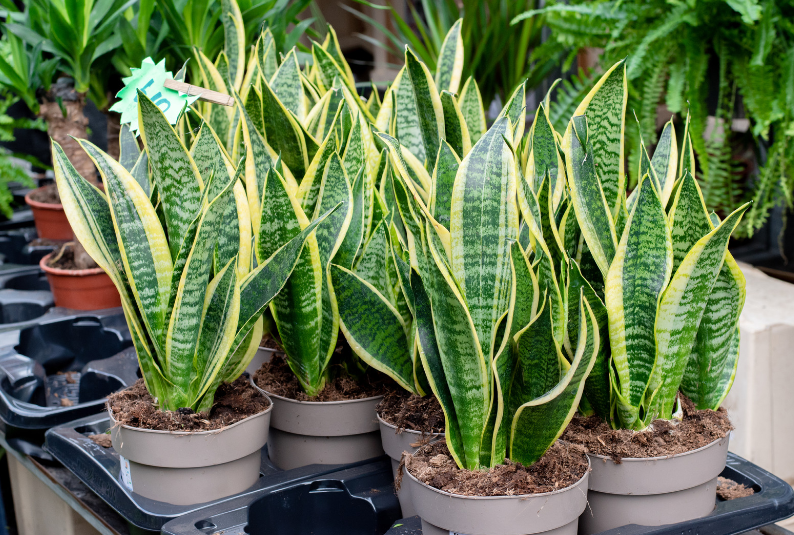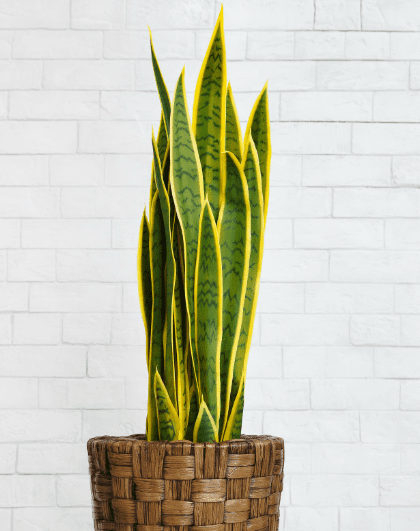
Snake plants are more than just a trendy houseplant; they’re a delightful addition to any home. You’ve come to the right place if you want to add a touch of greenery without much fuss. Let’s dive into everything you need to know about caring for your snake plant at home.
What Makes Snake Plants Special?
Snake plants, also known as sansevieria, are famous for their unique foliage and low light tolerance. They’re a beginner-friendly plant that adds height to your indoor collection and helps with indoor air purification by absorbing carbon dioxide and removing toxins like benzene and formaldehyde.
Choosing the Right Snake Plant Variety
There are several snake plant varieties to choose from:
- Dracaena trifasciata ‘Laurentii’: Known for its yellow-edged leaves.
- Sansevieria ‘Golden Hahnii’: A compact version perfect for small spaces.
- Cylindrical snake plant (Dracaena angolensis): Features round, upright leaves.
- White snake plant: Offers a striking contrast with its pale leaves.
Ideal Conditions for Your Snake Plant

Light Requirements
Snake plants thrive in indirect light but can also handle low light conditions. Avoid placing them in direct sunlight to prevent leaf burn.
Temperature and Humidity
They prefer a temperature range between 60-85°F. Normal indoor humidity levels are just fine, so there’s no need for a humidifier.
Soil Preferences
Use a well-draining soil mix, like a cactus potting mix, to prevent root rot. Adding some organic matter can boost soil health.
Watering Your Snake Plant
Overwatering is a common mistake. Allow the soil to dry out between waterings to avoid root rot. In the dormant phase during winter, water even less frequently.
Fertilizing Your Snake Plant
While snake plants are low-maintenance, giving them a nutrient boost during the growing season can promote healthier growth. Use a balanced all-purpose fertilizer or a slow-release 10-10-10 fertilizer to provide essential nutrients. It’s best to apply a diluted fertilizer at half strength to avoid the risk of over-fertilizing, which can damage the plant.
You can also enrich the soil with organic options like compost or well-rotted manure. These not only feed the plant but also improve soil quality. If you prefer liquid options, a liquid fertilizer works well when applied sparingly.
Be cautious not to fertilize a rootbound plant without repotting first, as limited soil can’t distribute nutrients effectively. Remember, moderation is key—overdoing it can do more harm than good.
Potting and Repotting
Proper potting is key to a healthy snake plant. Choose a terracotta pot, clay pot, or ceramic pot with ample drainage holes. These materials help with moisture wicking, preventing excess water that can lead to root rot. When you notice overcrowded roots or new offshoots, it’s a sign your plant may need repotting.
The ideal repotting frequency is every 2-3 years, preferably during spring repotting when the plant is gearing up for new growth. Gently remove the plant and check the root ball for any issues. Fill the new pot with well-draining soil to give your snake plant the best environment to thrive.
By paying attention to pot type and timing, you’ll ensure your snake plant stays happy and healthy for years to come.
Propagating Your Snake Plant
Propagation Methods
Expanding your snake plant collection is both fun and straightforward. One popular method is root division, where you separate the plant’s fleshy rhizomes or pups from the mother plant. Start by removing the plant from its pot and gently dividing the roots using a sharp knife or sterile cutting tool. Plant the offshoots in fresh potting soil or a cactus potting mix with free-draining soil to encourage healthy growth.
Another easy way is through leaf cuttings. Cut a healthy leaf into sections and allow them to callous over for a day to prevent rot. Place the cuttings in moist soil and wait for new shoots to emerge. This method is a bit slower but rewarding as you watch new plants develop from a single leaf.
Whichever method you choose, ensure you’re using the right soil and tools to give your new plants the best start possible.
Division Method
- Remove the plant from its pot.
- Use a sharp knife to divide the root ball.
- Plant the offshoots or pups in separate pots with free-draining soil.
Leaf Cuttings
- Cut a healthy leaf into sections.
- Let the cuts callous over for a day.
- Plant the cuttings in potting soil and wait for new shoots to emerge.
Pruning and Maintenance
Keeping your snake plant in top shape is easier than you might think. Regular pruning and maintenance enhance its appearance and promote compact growth.
Removing Damaged or Diseased Leaves
Spotting damaged leaves or diseased leaves? It’s time for some routine trimming. Use pruning shears or a sterile cutting tool to carefully cut these leaves off at the soil line. This helps prevent potential pest infestation and keeps your plant healthy.
Dusting the Leaves
Believe it or not, dust can hinder your plant’s photosynthesis. Gently wipe the leaves with a microfiber cloth to remove any dust buildup. This simple step allows your snake plant to absorb light more efficiently.
Best Time for Pruning
The growing season is the ideal time for most of your pruning tasks. However, a little winter pruning can be beneficial if you notice any issues. Just be gentle, as the plant is less active during colder months.
By incorporating these easy steps into your care routine, you’ll ensure your snake plant continues to thrive and look its best.
Common Problems and Troubleshooting
Overwatering and Root Rot
Signs include yellow or brown leaves and foul-smelling soil. Ensure your pot has good drainage and adjust your watering schedule.
Pests
Watch out for thrips and other pests. Treat infestations with neem oil or other natural remedies.
Leaf Discoloration
Curling or droopy snake leaves can indicate insufficient light or other issues. Adjust the plant’s location and care routine accordingly.
Fertilizing Mistakes to Avoid
Avoid using too much liquid fertilizer or applying it during the plant’s dormant phase. Stick to a diluted fertilizer and follow a schedule during the growing season.
Safety Concerns: Toxicity
Be cautious if you have pets or young children. Snake plants contain saponins, which can cause nausea, vomiting, and diarrhea if ingested.
Benefits of Having a Snake Plant
Beyond aesthetics, snake plants offer:
- Air purification by removing toxins.
- Minimal water requirement, making them drought-resistant.
- Forgiving nature is ideal for those new to plant care.
Enhancing Your Home with Snake Plants
Their compact growth habit and unique foliage make snake plants perfect for any space. Whether you’re looking to add a touch of green to your office or bedroom, they’re a fantastic choice.
Final Tips for Success
- Use LED grow lights if natural light is scarce.
- Keep an eye on the soil pH to ensure optimal growth.
- Regularly check for signs of pest infestation or disease.
Join the Snake Plant Community
Caring for a snake plant is a rewarding experience. Share your journey with fellow plant enthusiasts and enjoy the many benefits this resilient plant has to offer.
Common Problems and Troubleshooting
Even though snake plants are hardy, they can still face a few issues. One common problem is overwatering, which can lead to root rot. Signs of this include yellow or brown leaves and foul-smelling soil. To prevent this, ensure your plant has good drainage and avoid using poor potting material that retains too much moisture.
If you notice curling leaves or a droopy snake plant, this might indicate insufficient light. Move your plant to a brighter spot to help it recover. Pests like thrips can also affect snake plants, causing damage to the leaves. Treat infestations by applying neem oil and regularly inspecting your plant for signs of bugs.
Monitoring these common issues and adjusting your care routine can keep your snake plant healthy and thriving.


























